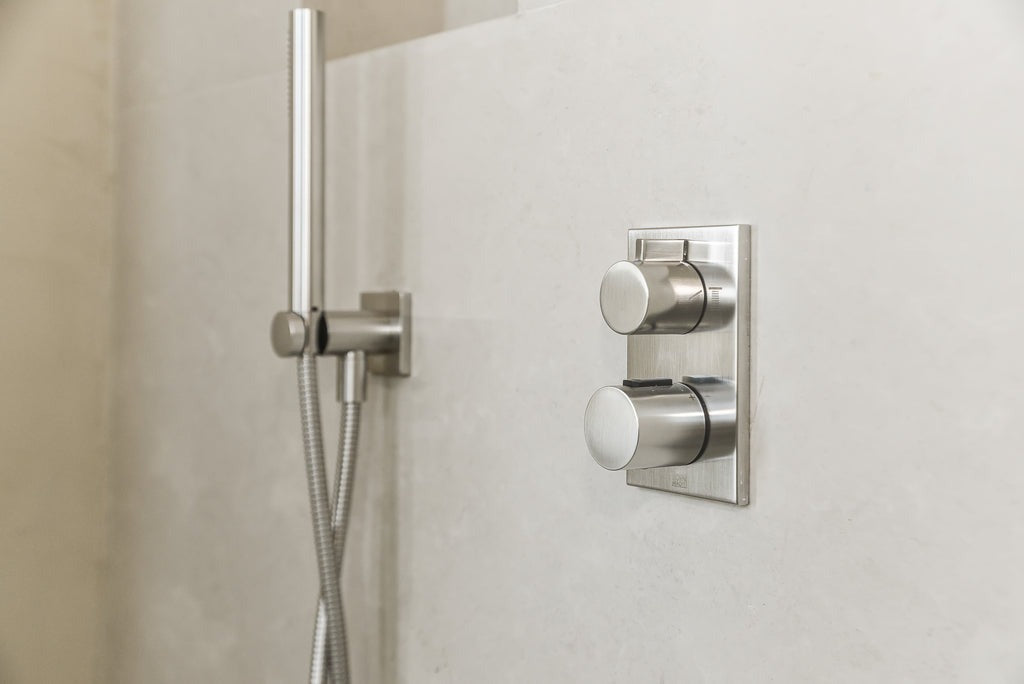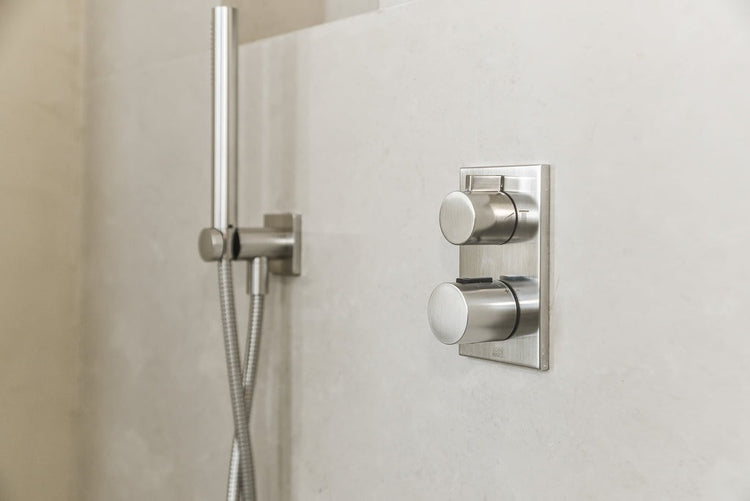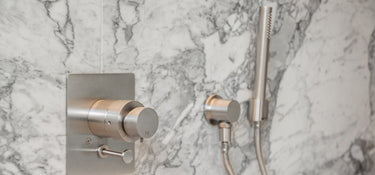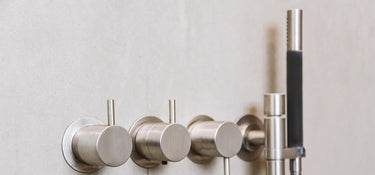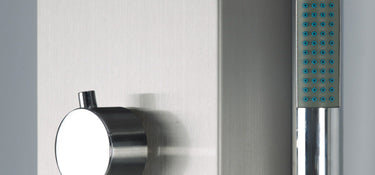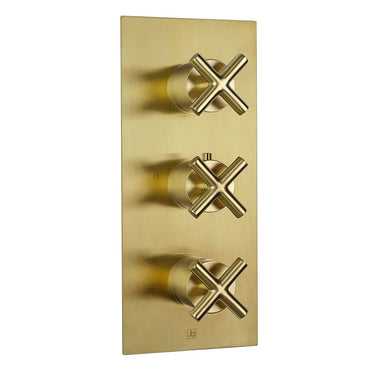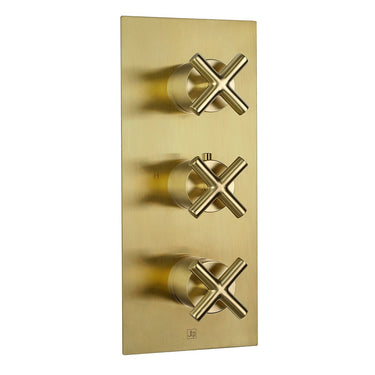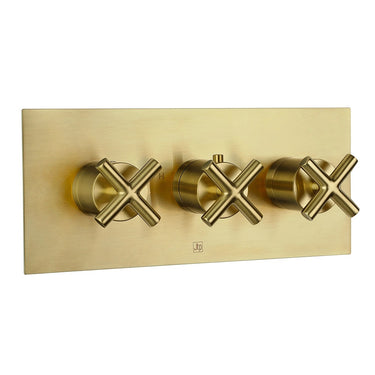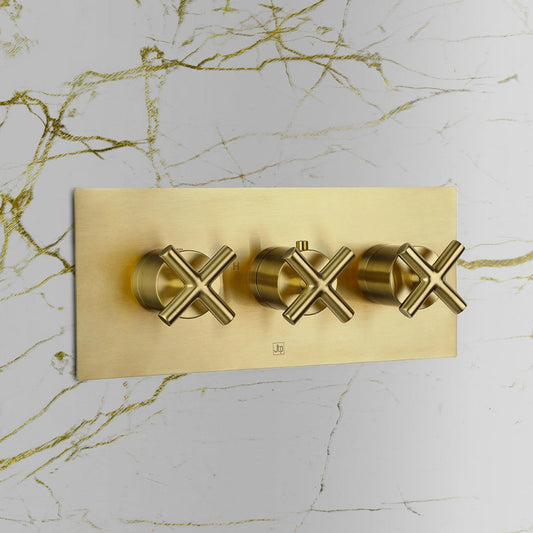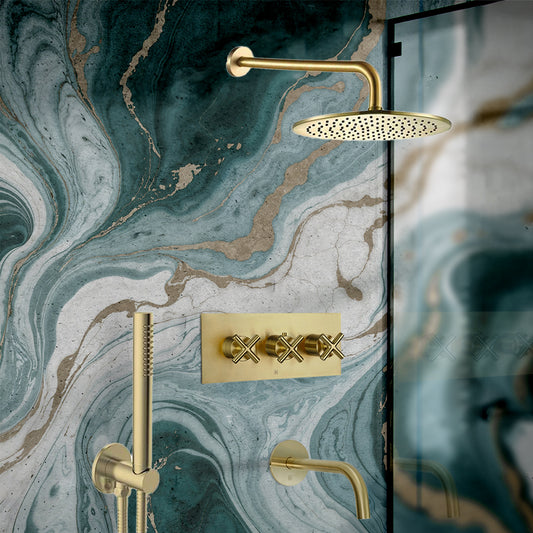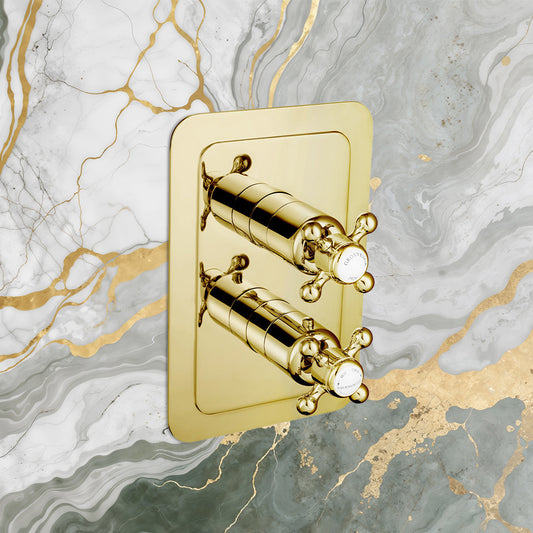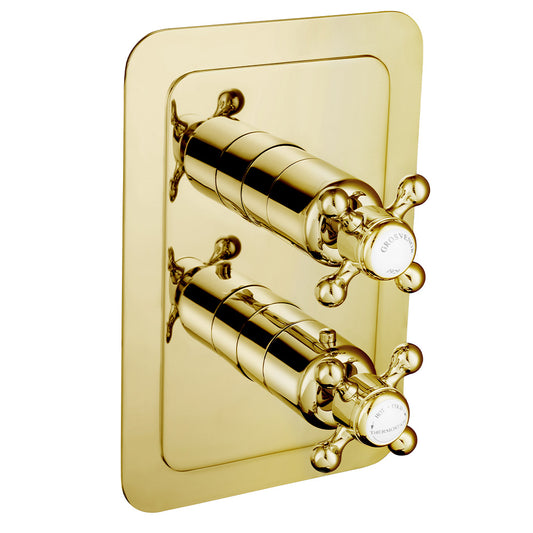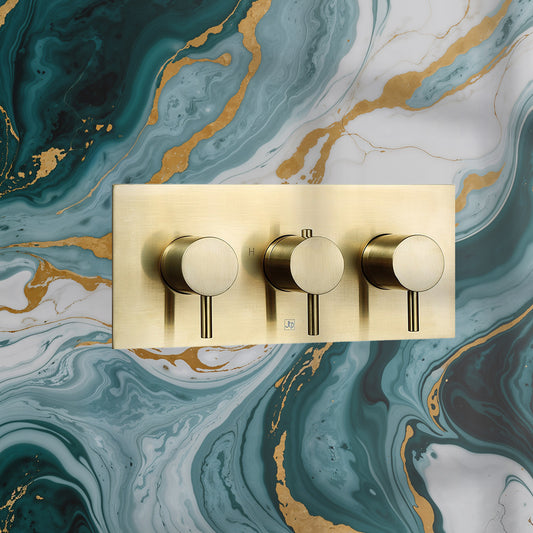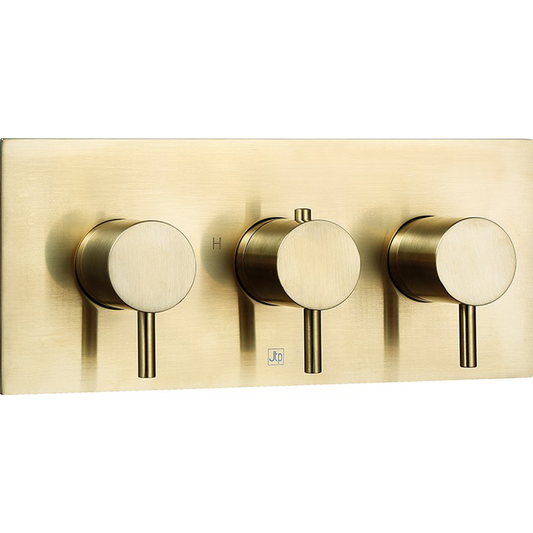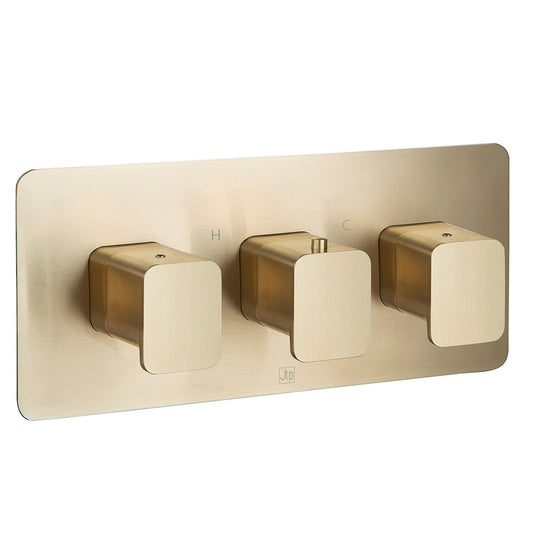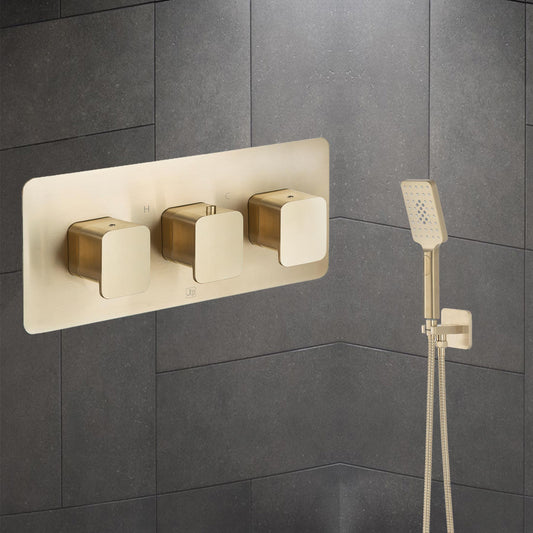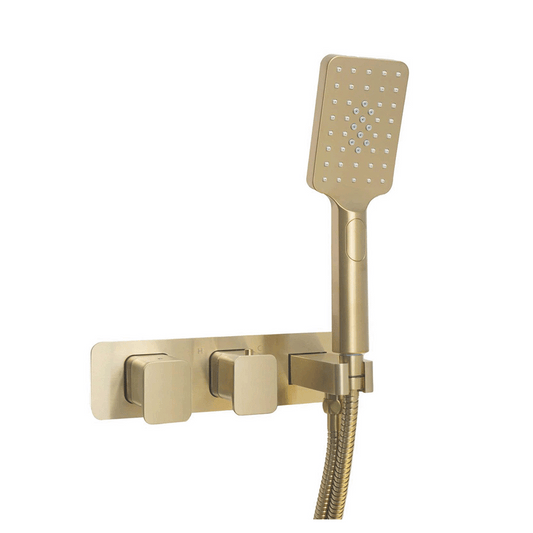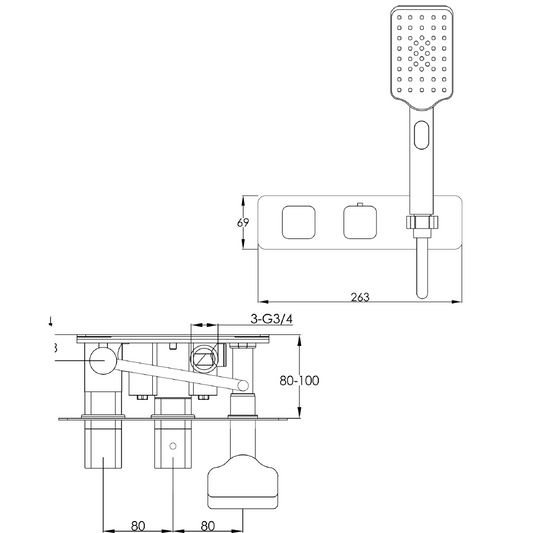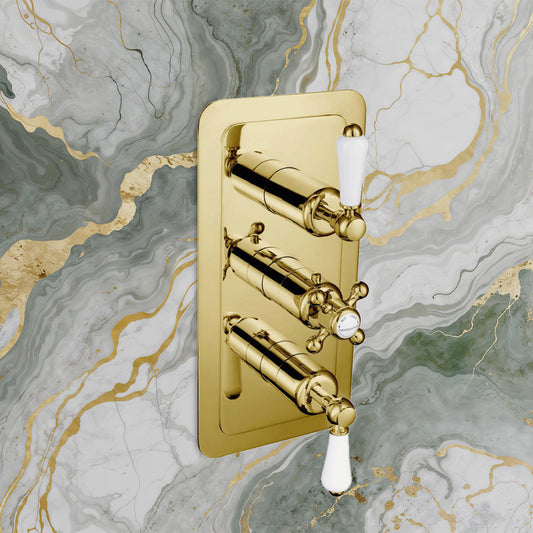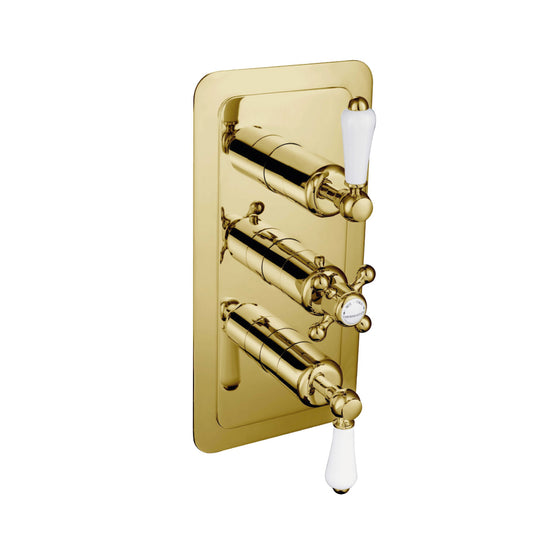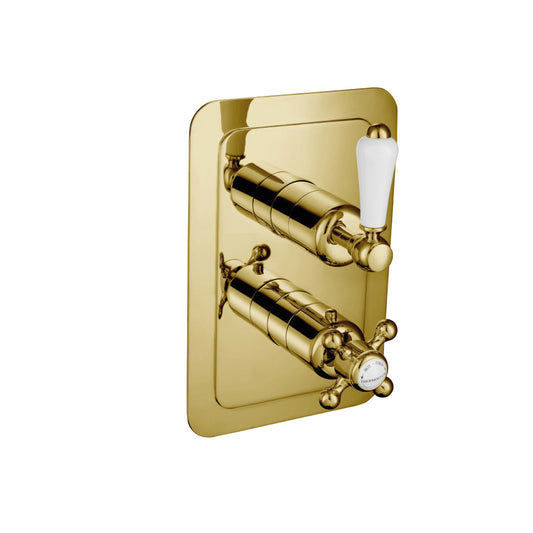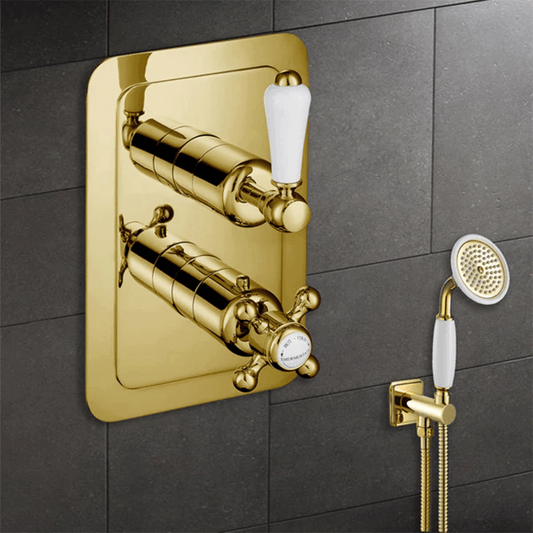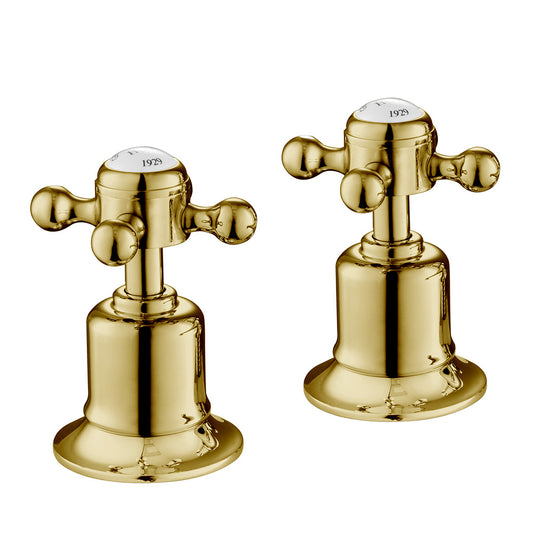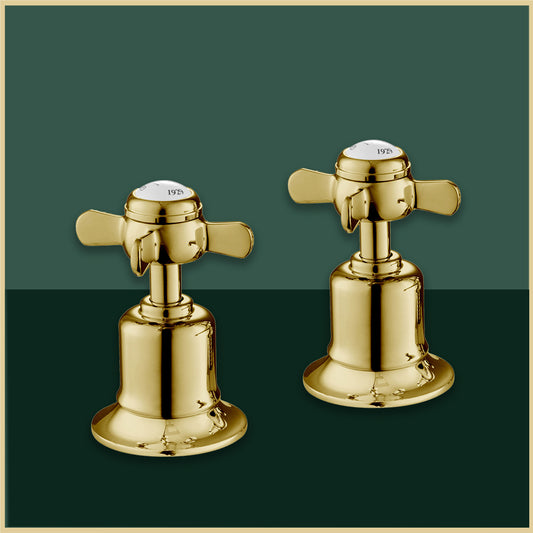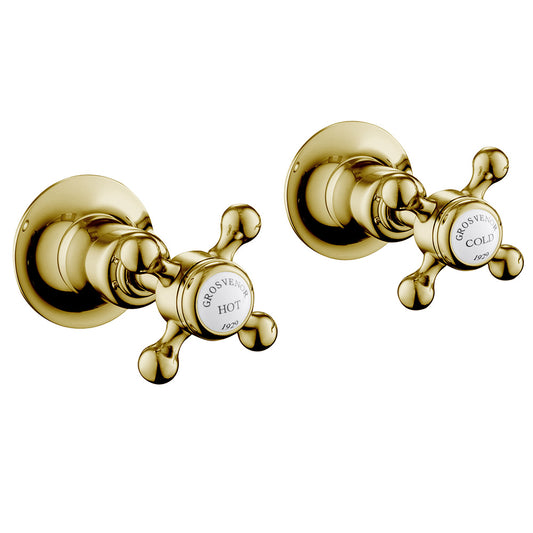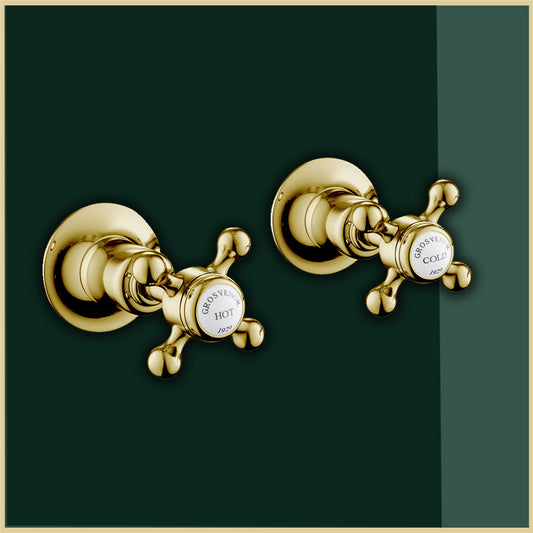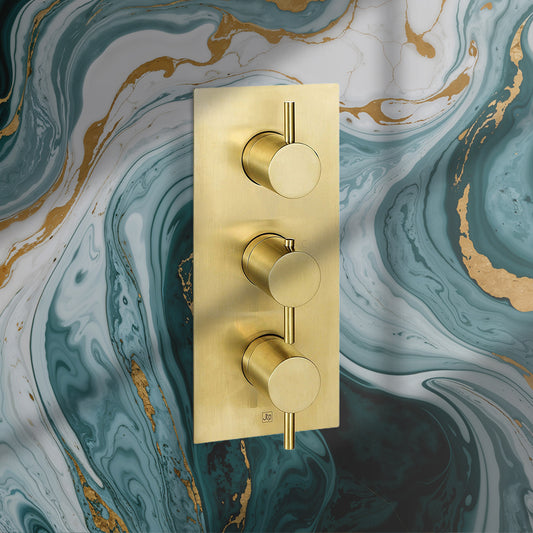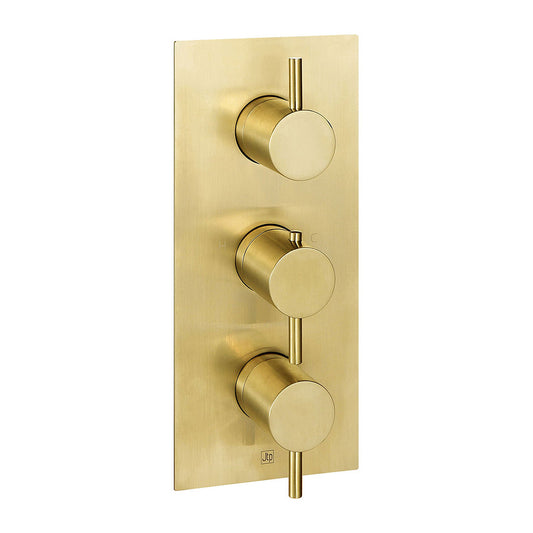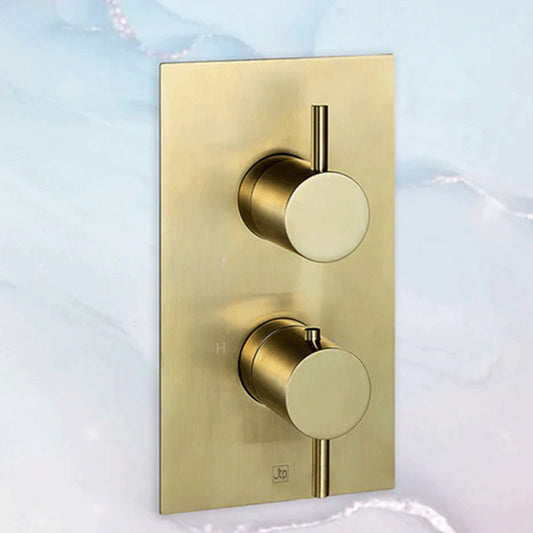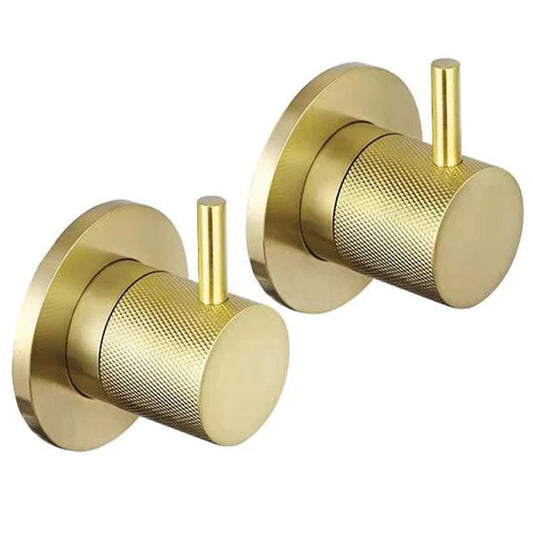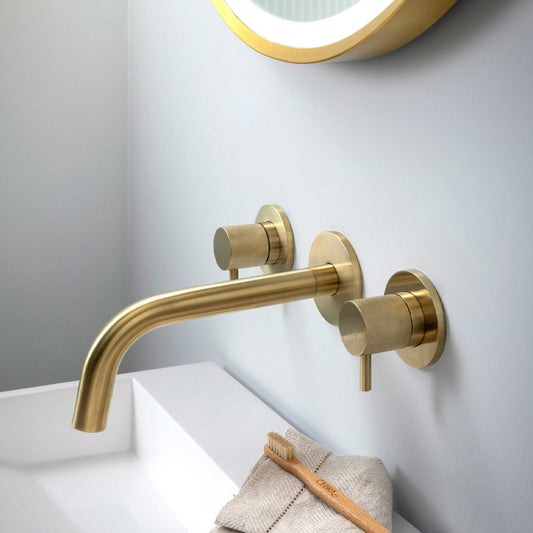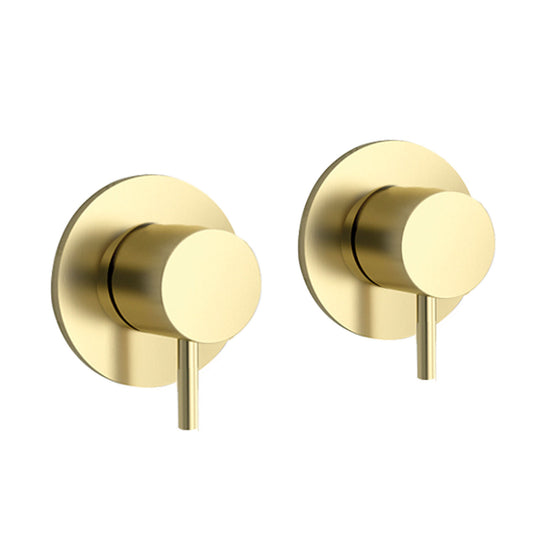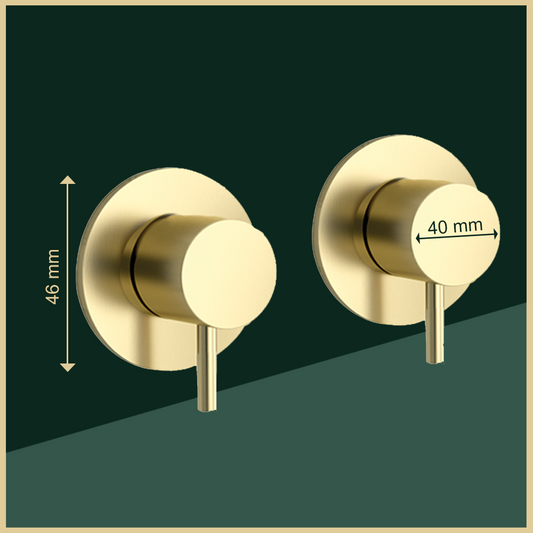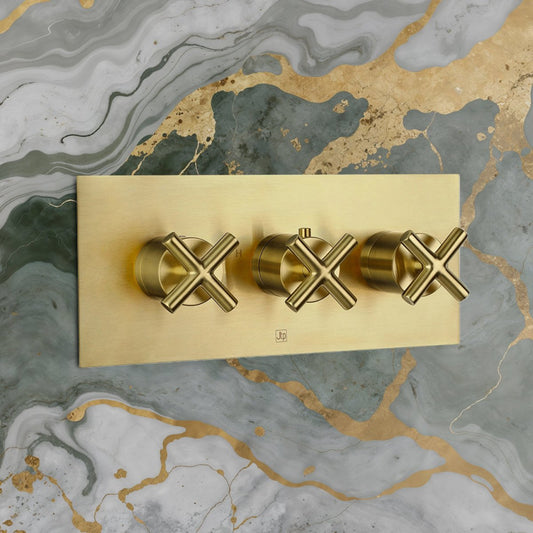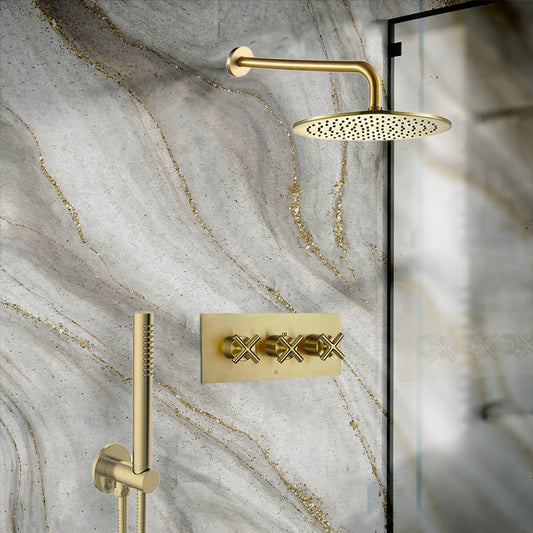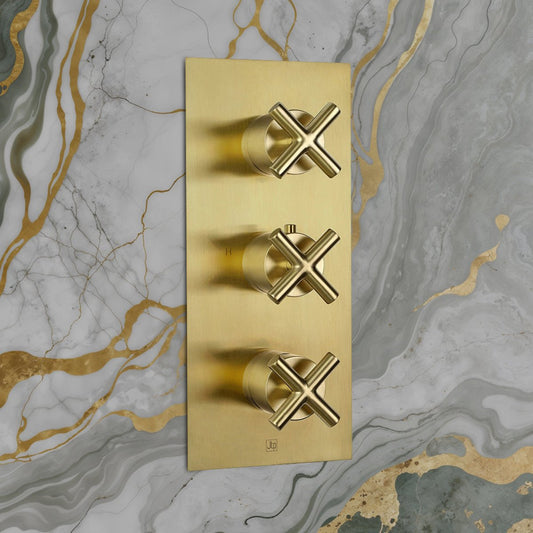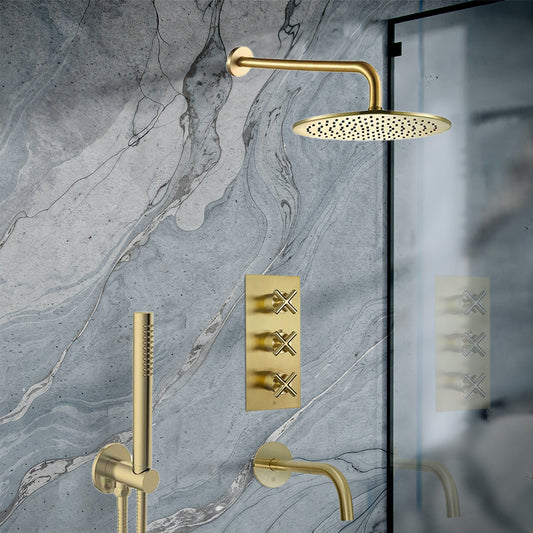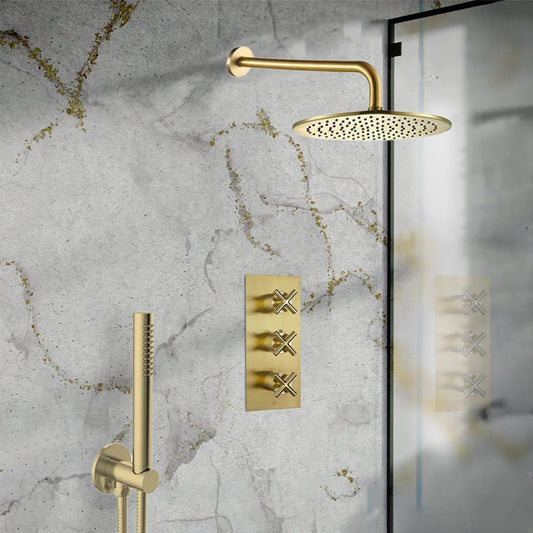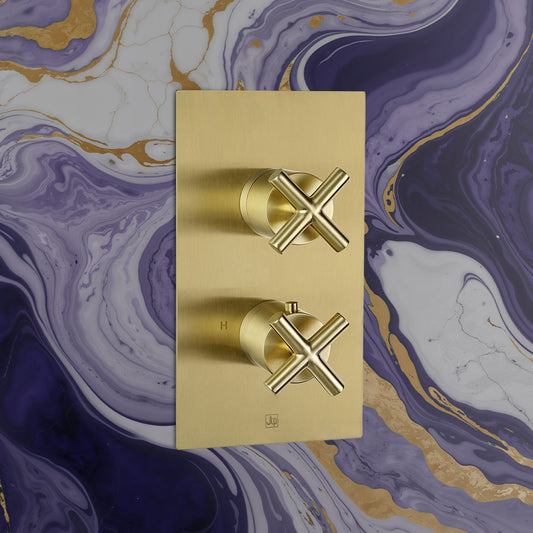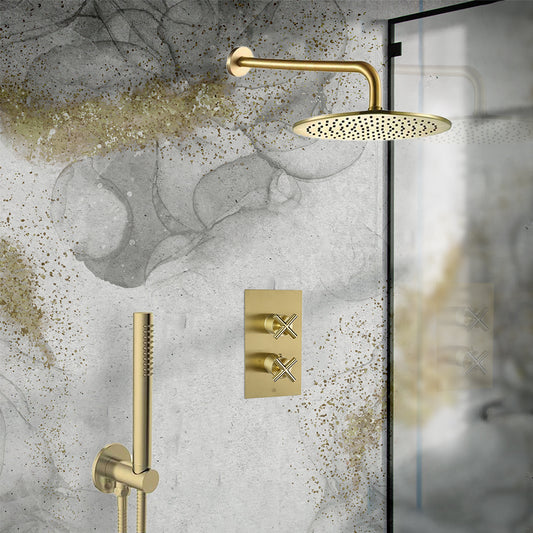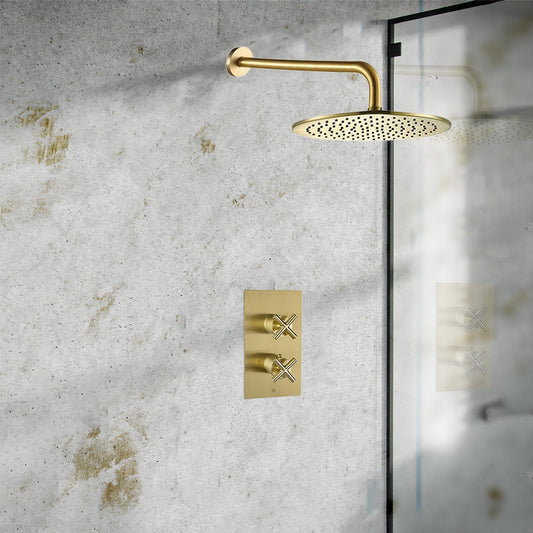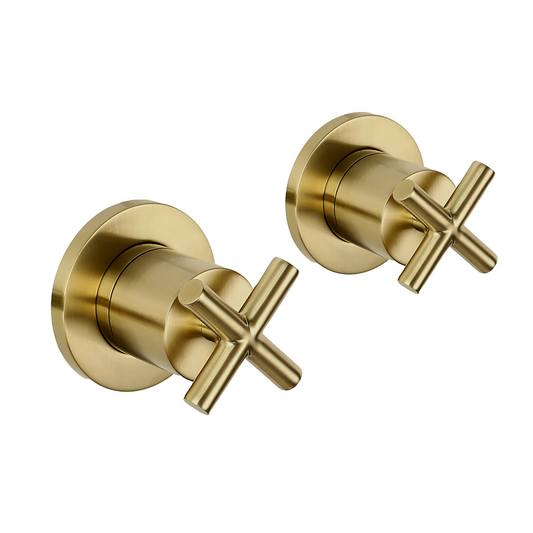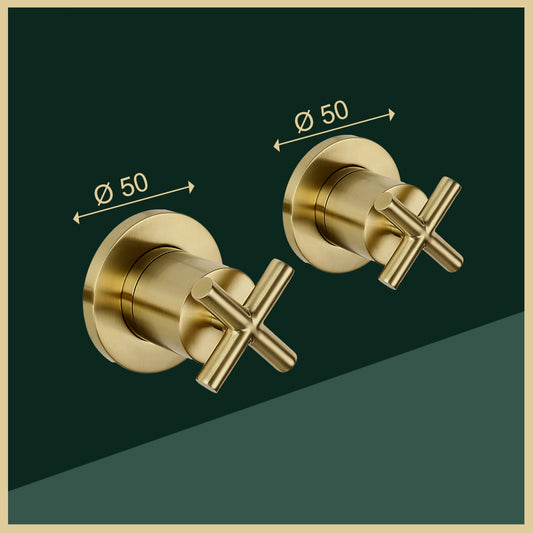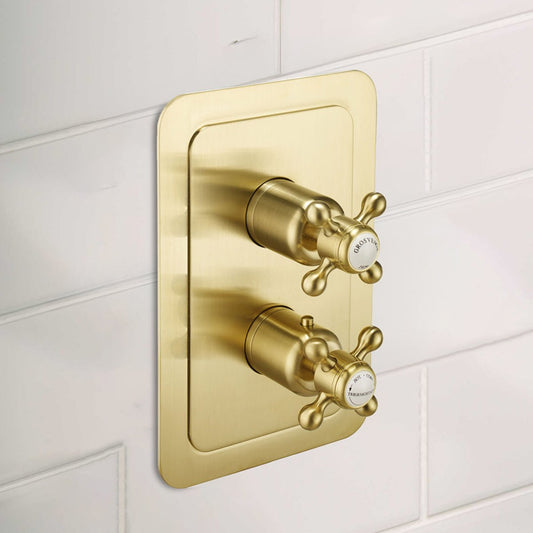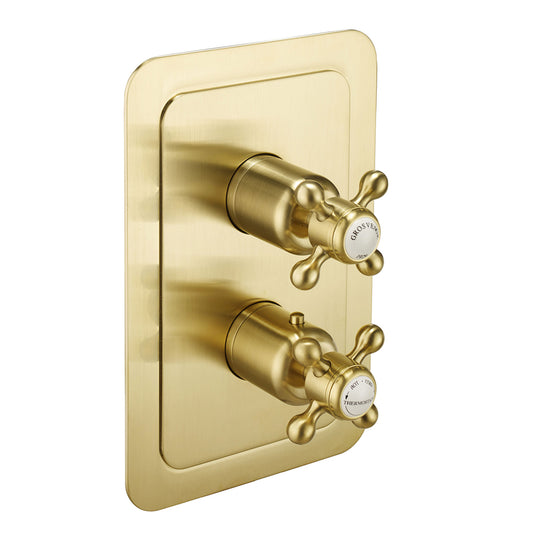The Complete Guide to Shower Valves and Shower Controls for Your Bathroom
Table Of Contents:
-
Introduction
→ -
Shower Valves Collection
→ -
Understanding Shower Valves and Controls
→ -
Choosing the Right Valve and Control Combination
→ -
Is It Time to Replace Your Shower Valve? Signs and Solutions
→ -
Cost of Shower Valve in the UK
→ -
Single-Handle vs. Multi-Handle Shower Controls
→ -
Thermostatic vs. Manual Valves: Which One is Right for You?
→ -
Installation and Maintenance Tips for Shower Valves
→ -
Match Your Shower Valve and Controls with Your Bathroom’s Style
→ -
Conclusion
→ -
Frequently Asked Questions
→
Introduction
A shower valve is a fundamental part of your bathroom's plumbing system, playing a crucial role in regulating the water flow and temperature during your shower. This small but essential fixture ensures that you can adjust your shower to the perfect temperature, whether you prefer a relaxing hot shower or a cool refreshing one. Without a properly functioning shower valve, you would face inconsistency in water pressure, temperature fluctuations, or, worse, no hot water at all. Shower controls are what you use to manipulate the valve, providing you with the ability to adjust both the flow and the temperature, making your shower experience more comfortable and customizable.
The right choice of shower valve can dramatically improve the quality of your daily routine. With advancements in plumbing technology, there are now various types of valves available, offering a range of features such as thermostatic control, pressure balancing, and even digital controls. Understanding which type suits your needs, whether for precise temperature control, pressure regulation, or simply for aesthetic appeal, can significantly enhance your bathroom setup. In this guide, we will delve into the different types of shower valves and controls, offer tips on selecting the best option for your space, and provide you with important maintenance and replacement advice. By the end of this guide, you’ll be equipped with the knowledge needed to keep your shower running efficiently and comfortably for years to come.
Understanding Shower Valves and Controls
Shower valves and controls are fundamental elements in your bathroom's plumbing system, crucial for regulating both water temperature and flow. These components work together to ensure your shower experience is comfortable, safe, and efficient. Whether you’re renovating your bathroom or simply upgrading your current system, understanding the functionality of shower valves and controls will help you make informed choices that improve your overall showering experience.

Shower Valve: The Heart of the System
The shower valve is the internal mechanism responsible for controlling the water that flows to your showerhead. Typically installed behind the wall, the valve acts as a gatekeeper, managing both the volume and temperature of water entering the shower. When you adjust your shower controls (whether by turning a knob, lever, or digital interface), you're actually changing how much hot or cold water flows through the valve.
There are two main types of valves:
-
Pressure-Balancing Valve: This valve regulates water pressure by balancing the hot and cold water lines. If someone in your home uses a different tap, the pressure-balancing valve ensures that you won’t experience drastic temperature fluctuations. For instance, if someone flushes the toilet while you’re in the shower, the temperature won’t suddenly become scalding hot or freezing cold.
-
Thermostatic Valve: This valve goes a step further by not only balancing pressure but also maintaining a consistent temperature. It automatically adjusts the mix of hot and cold water to keep the temperature stable throughout your shower. Thermostatic valves are especially beneficial in households with multiple bathrooms or where water pressure may fluctuate frequently.
-
Diverter Valve: This valve is used when you have multiple water outlets (such as a showerhead and a handheld shower). The diverter allows you to switch the flow of water between different outlets, giving you flexibility and control over where the water goes.
Shower Controls: The Interface Between You and the Valve
Shower controls are the user interface for the shower valve. These controls allow you to adjust water flow, temperature, and sometimes even activate additional features, such as water-saving modes or multiple showerheads. Shower controls can come in several configurations, and choosing the right one depends on your preferences and the complexity of your plumbing system.
-
Single-Handle Controls: These controls are simple and easy to use. With a single handle, you can adjust both the temperature and flow of water simultaneously, making them ideal for small bathrooms or for homeowners who prefer minimalism. The control lever typically rotates to adjust the temperature, with the handle pushing in or pulling out to control the water flow.
-
Dual-Handle Controls: Dual-handle controls give you more precise control over the hot and cold water separately. With one handle for hot water and another for cold, you can mix the two to achieve your desired temperature. While these systems offer more customization, they can sometimes be less intuitive than single-handle options, requiring you to fine-tune each handle to get the perfect mix.
-
Digital or Touchscreen Controls: For a more high-tech experience, digital shower controls allow you to set your desired temperature with the push of a button or tap on a screen. Some systems even allow you to pre-set your temperature and save your preferences for future use. These controls often come with advanced features such as water flow regulation, pre-shower timers, and even smart home integration, making them ideal for tech-savvy homeowners looking for ultimate convenience.
-
Manual vs. Smart Controls: While traditional manual controls (like levers and knobs) are simple and reliable, smart shower controls are increasingly popular. These systems allow you to customize your shower experience more precisely, with features like temperature presets, water-saving modes, and even voice control through virtual assistants like Alexa or Google Assistant. Although they tend to be more expensive, they offer convenience, luxury, and energy savings.
Choosing the Right Valve and Control Combination
When selecting the right shower valve and control combination for your bathroom, it’s important to take several factors into consideration. Your decision will influence your shower's performance, comfort, and efficiency. The ideal valve and control setup should align with your bathroom's design, your household’s needs, and your personal preferences. Here’s how you can make an informed choice:
1. Consider the Size and Layout of Your Bathroom
The layout of your bathroom can help dictate the kind of valve and control system you should choose. In larger, more luxurious bathrooms, a thermostatic valve with multiple controls may be ideal to manage multiple showerheads or features like rain showers, handheld showers, or body sprays. For smaller bathrooms or tighter spaces, a single-handle valve system may be more practical and space-efficient, allowing for ease of use and a more streamlined look.
2. Water Pressure and Flow Requirements
Understanding the water pressure in your home is crucial to selecting the right valve. If you have low water pressure, a pressure-balancing valve can ensure a steady water flow and prevent sudden temperature changes when other water outlets are in use, such as when a toilet is flushed. On the other hand, if you have high water pressure, a thermostatic valve can provide added stability by maintaining a constant temperature despite fluctuations in pressure.
For homes with multiple bathrooms or where multiple people use the shower simultaneously, opting for a thermostatic valve or pressure-balancing valve might be beneficial for maintaining comfort and avoiding drastic temperature changes. Digital controls can be an excellent choice here, as they offer precision in temperature settings.
3. Ease of Use and Control
Consider who will be using the shower in your household. If you have young children, elderly family members, or anyone who might struggle with adjusting water temperature or flow, a single-handle control may be the best option. Single-handle systems allow for simple adjustments of both temperature and flow with one movement, offering convenience and ease of use.
In contrast, if you prefer more control and the ability to fine-tune water temperature, a dual-handle control system can be ideal. Dual controls are also better for households where multiple people need to adjust the water to their specific preferences.
For those looking for the ultimate in convenience and luxury, digital or touchscreen controls are available. These allow you to set your desired temperature precisely and can offer additional features like water-saving modes, timers, or even voice control integration. While these systems are more advanced and tend to be on the pricier side, they provide a futuristic, spa-like experience and are perfect for anyone looking for a high-end, customizable shower experience.
4. Aesthetic Preferences and Bathroom Design
The aesthetic appeal of your shower valve and controls is also a key consideration. Shower controls come in a range of styles, finishes, and materials, including polished chrome, matte black, brushed nickel, and gold, among others. Choose a valve and control system that complements the overall design of your bathroom. For instance, if you have a minimalist, modern bathroom, a sleek, single-handle thermostatic valve in a clean finish like chrome or matte black can tie the whole look together.
Alternatively, if your bathroom leans more towards a traditional or vintage style, you may want to opt for a dual-handle valve with more ornate handles and a classic finish. It's essential to balance both function and design to create a cohesive look that enhances the overall feel of your bathroom.
5. Budget Considerations
The cost of shower valves and controls can vary significantly depending on the type and features. Basic pressure-balancing or manual systems are typically more affordable, while thermostatic and digital systems come with a higher price tag due to their advanced features and precision control. Be sure to balance your budget with the functionality you need. While digital systems offer cutting-edge convenience, they may not be necessary if you’re looking for something simple and reliable.
Additionally, don’t forget to factor in the installation cost. More complex valve and control systems, particularly digital or thermostatic ones, may require professional installation, which can increase the overall cost.
6. Maintenance and Longevity
Shower valves and controls need regular maintenance to ensure they function properly. Some valve types, like thermostatic valves, may require occasional servicing to keep them working efficiently. Make sure to choose a valve and control system that is durable and has a good warranty, especially if you’re investing in a higher-end model. While digital controls are convenient, they may require more attention to maintain, and parts can be expensive to replace.
Ultimately, choosing the right valve and control combination comes down to finding a balance between functionality, style, and budget. By understanding your household’s needs, your water pressure situation, and your aesthetic preferences, you can select a system that not only meets your practical requirements but also enhances your bathroom’s design. Whether you opt for a simple single-handle control, a more advanced thermostatic valve, or a digital, smart system, the right choice will provide you with years of comfort, convenience, and control over your shower experience.
Is It Time to Replace Your Shower Valve? Signs and Solutions
Shower valves play an essential role in regulating the water flow and temperature in your shower. Like all plumbing fixtures, they can wear out over time and may require replacement. If you notice any of the following signs, it could indicate that your shower valve needs attention or replacement. Understanding these signs early on can help you avoid costly repairs and ensure that your shower remains functional and safe. Here are the common signs to look out for and the solutions to address them:
1. Inconsistent Water Temperature
-
Sign: One of the most noticeable signs that your shower valve may be failing is inconsistent water temperature. If the water temperature fluctuates between hot and cold, even though you haven’t adjusted the controls, the valve may be malfunctioning. This issue is particularly common in pressure-balancing valves, which regulate the water temperature according to pressure changes.
-
Solution: If the problem persists after adjusting the water pressure or temperature, the valve may need to be replaced. In some cases, it may be possible to repair or clean the valve, but persistent issues typically require a new valve installation to restore stable temperature control.
2. Low Water Pressure
-
Sign: Another indication that it might be time to replace your shower valve is low water pressure. If your shower has a weak flow of water even after cleaning the showerhead and removing any blockages, the valve could be to blame. Over time, minerals and debris can accumulate inside the valve, affecting the water flow.
-
Solution: First, check the showerhead and plumbing for blockages. If the water pressure remains low, the valve may need to be replaced or serviced. A new valve can improve water flow and restore consistent pressure throughout the shower.
3. Water Leaks Around the Valve
-
Sign: Water leaks around the valve handle or in the surrounding area can be a serious issue. This can happen due to worn-out seals, gaskets, or corrosion within the valve assembly. If you notice persistent leaks even after tightening the handles, it’s a strong sign that the valve has been damaged and is no longer functioning properly.
-
Solution: In some cases, replacing the washers or seals inside the valve can resolve the issue. However, if the leak continues, the entire valve may need to be replaced to prevent water damage and further complications.
4. Difficulty Adjusting Water Flow or Temperature
-
Sign: If you find it difficult to adjust the water flow or temperature, or if the controls are becoming stiff or unresponsive, the valve could be the problem. This may indicate internal wear and tear, such as a corroded cartridge or damaged internal parts.
-
Solution: A new valve or cartridge may be required to restore smooth, easy control of the water flow and temperature. Sometimes, a simple cleaning or lubricating of the valve can help, but it’s essential to address this issue before it gets worse.
5. Corrosion or Rust Around the Valve
-
Sign: If you notice visible signs of rust or corrosion around the shower valve, it could be a sign of a leak or that the valve is deteriorating. Over time, exposure to water and humidity can cause metal components of the valve to corrode.
-
Solution: Corroded parts usually need to be replaced to avoid further deterioration and leaks. If the valve is old and rusted, it’s best to replace it entirely to ensure reliable and safe shower performance.
6. Noisy Valve Operation
-
Sign: If you hear strange noises like a whining, squealing, or banging sound when you turn the shower on or adjust the temperature, it could be due to a problem with the valve. This is often caused by debris in the valve or a buildup of mineral deposits that restrict water flow.
-
Solution: The valve may need to be cleaned or replaced. In cases of mineral buildup, flushing the valve with vinegar can sometimes resolve the issue. If the noise continues, replacing the valve might be necessary to ensure smooth operation.
7. Age of the Shower Valve
-
Sign: If your shower valve is very old, it may be time for a replacement, even if it hasn’t shown significant signs of malfunction yet. Older valves may no longer meet modern plumbing standards, and they can become less reliable as time goes on.
-
Solution: Replacing an outdated valve with a newer, more efficient model can help prevent potential future problems. It’s a good idea to replace your valve if it’s nearing the end of its lifespan, particularly if it hasn’t been serviced or maintained for many years.
Solutions for Valve Replacement:
If you experience any of the above issues, you can either attempt to repair the valve or replace it entirely. Here are some options:
-
Repairing the Valve: If the valve is not completely damaged, repairing it by replacing worn-out components like the cartridge, seals, or washers might be sufficient. This can be a more cost-effective solution than a full replacement.
-
Replacing the Valve: If the valve has sustained significant damage or is too old to repair effectively, replacing it entirely is the best option. You can choose from a variety of modern shower valves, such as thermostatic, pressure-balancing, or digital valves, depending on your needs and preferences.
When to Call a Professional:
While some homeowners may choose to attempt valve repairs themselves, it’s important to call a plumber for more complex issues or if you are unsure about the cause of the problem. Plumbing work can be complicated, and improper installation or repair of a shower valve can lead to further issues down the line. A professional plumber will have the necessary expertise to install a new valve properly and troubleshoot any underlying problems.
In conclusion, regularly monitoring your shower valve for signs of malfunction can save you time, money, and frustration in the long run. If you notice any of the signs mentioned above, it’s essential to address the issue promptly, whether by repairing or replacing the valve. By doing so, you can ensure that your shower remains a comfortable and reliable part of your bathroom for years to come.
Cost of Shower Valve in the UK
The cost of a shower valve can vary depending on the type, brand, and features you choose. Whether you're replacing an old valve or installing a new one, it's essential to factor in the cost of the valve itself, installation, and any additional parts or components that may be necessary. Here's a breakdown of the typical costs associated with shower valves in the UK:
1. Standard Shower Valve
-
Cost Range: £30 to £100
-
Description: Standard shower valves, often including basic pressure-balancing or manual control systems, are typically the most affordable options. These valves may not have advanced features like thermostatic controls but are adequate for most standard showers.
-
Features: Simple water temperature and flow control, often with one or two handles.
2. Thermostatic Shower Valve
-
Cost Range: £100 to £250
-
Description: Thermostatic shower valves allow for precise temperature control and are ideal for homes with inconsistent water pressure. These valves automatically adjust the temperature if there’s a sudden change in water pressure, ensuring a comfortable and safe shower experience.
-
Features: Temperature stability, protection from sudden temperature spikes, multiple temperature settings.
3. Digital Shower Valve
-
Cost Range: £200 to £600
-
Description: Digital shower valves are a high-tech option that provides precise control over water temperature and flow. These valves often feature a digital display and can be integrated into modern, smart home systems. They are more expensive due to their advanced technology and ease of use.
-
Features: Digital controls, touchscreen interfaces, customizable settings, remote control options.
4. Diverter Shower Valve
-
Cost Range: £50 to £150
-
Description: A diverter valve is used to switch between different water outlets, such as a showerhead and a handheld shower. These are commonly found in showers with multiple water sources, such as rainheads and handheld showers.
-
Features: Simple control over multiple outlets, typically with a single handle or lever.
5. Exposed Shower Valve
-
Cost Range: £100 to £300
-
Description: Exposed shower valves are installed on the exterior of the wall, which gives a more traditional or vintage look. These valves are ideal for retrofitting in bathrooms with limited space or where you want to create a period-style shower.
-
Features: Classic design, visible plumbing fixtures, easy installation in retrofitting projects.
6. Concealed Shower Valve
-
Cost Range: £150 to £350
-
Description: Concealed shower valves are hidden within the wall, offering a clean, modern look. They are typically more expensive than exposed valves due to the additional installation work involved, but they provide a sleeker, minimalist aesthetic.
-
Features: Hidden behind the wall, sleek and modern design, requires professional installation.
Additional Costs to Consider
-
Installation Costs: The cost of installing a shower valve can vary depending on the complexity of the job and the plumber’s rates. Installation typically costs between £100 and £250 for a basic valve. However, for more complex systems like digital or thermostatic valves, the installation cost can rise to £400 or more.
-
Replacement Parts: If you're replacing parts like cartridges, seals, or washers, these can add an additional £10 to £50 to the total cost. It's important to keep in mind that a new valve may also require some modifications to your plumbing, especially if you're upgrading to a more advanced system.
-
Labour Costs: The average hourly rate for a plumber in the UK is around £40 to £80, depending on their experience and location. Simple valve replacements typically take about 1 to 2 hours, while more complex installations can take longer.
Overall Cost Breakdown
-
Basic Shower Valve: £30 to £100 (excluding installation)
-
Thermostatic Valve: £100 to £250 (excluding installation)
-
Digital Valve: £200 to £600 (excluding installation)
-
Diverter Valve: £50 to £150 (excluding installation)
-
Installation Costs: £100 to £250 (basic), £250 to £400 (complex installations)
The cost of a shower valve in the UK can vary significantly depending on the type and features you choose. Basic models are relatively inexpensive, while advanced options such as thermostatic or digital valves can cost several hundred pounds. It's important to also factor in installation and any additional parts needed when calculating the overall cost of a shower valve replacement or upgrade. Consider your needs, budget, and the overall design of your bathroom when choosing the best shower valve for your home.
Single-Handle vs. Multi-Handle Shower Controls: Which Is Right for Your Home?
When it comes to choosing the best shower control system for your bathroom, one of the key decisions you’ll need to make is whether to go for a single-handle or multi-handle shower control. Both have their own advantages and considerations, and the choice largely depends on your preferences, bathroom style, and ease of use. Below, we’ll break down the differences between single-handle and multi-handle shower controls to help you make an informed decision.

Single-Handle Shower Controls
A single-handle shower control uses one lever or knob to regulate both water temperature and flow. It’s typically the most modern and user-friendly option, offering a streamlined and minimalist look for your bathroom.
Advantages of Single-Handle Shower Controls:
-
Ease of Use: Single-handle controls are simple to operate with one hand, making it easier to adjust the water temperature and flow. This is especially helpful for people with mobility issues or those who prefer a more intuitive control system.
-
Space-Saving Design: Because there is only one handle, single-handle controls take up less space on your shower wall, making them perfect for smaller bathrooms or modern, minimalist designs.
-
Faster Temperature Adjustment: The single lever allows you to adjust both the flow and temperature at the same time, making it easier to find the ideal water temperature quickly and efficiently.
-
Modern Appearance: Single-handle systems tend to offer a sleek and contemporary look, complementing modern bathroom designs and adding a touch of sophistication.
Considerations for Single-Handle Shower Controls:
-
Limited Control Over Temperature and Flow: While the single handle adjusts both aspects simultaneously, you might find it less precise than multi-handle controls, especially when you need very specific temperature settings.
-
Water Pressure Variations: If you experience fluctuating water pressure, single-handle controls may require more fine-tuning to maintain the desired water temperature.

Multi-Handle Shower Controls
Multi-handle shower controls, often featuring two or more separate handles, give you more specific control over both water temperature and flow. These systems often have one handle for hot water, one for cold, and sometimes an additional one for controlling the water flow or diverting to multiple outlets, such as a handheld showerhead or a rain shower.
Advantages of Multi-Handle Shower Controls:
-
Precise Control: With separate handles for hot and cold water, multi-handle systems allow you to fine-tune the temperature more accurately. You can adjust the flow and temperature independently, which is ideal for those who like to have more control over their shower settings.
-
Classic Look: Multi-handle systems often give a more traditional, luxurious appearance, making them a great choice for vintage or high-end bathroom designs.
-
Ideal for Large Showers: If you have a large shower area with multiple outlets, such as a rain showerhead, body jets, or a handheld shower, a multi-handle control system can make it easier to manage the different water flow settings.
Considerations for Multi-Handle Shower Controls:
-
More Complex to Use: While multi-handle controls provide more precise temperature and flow adjustments, they can be a bit more complicated to use, especially for people who are not familiar with them. It may take longer to find the right water temperature and flow.
-
More Space Required: Multi-handle systems require more space on your shower wall for the handles, which may not be ideal for smaller bathrooms or minimalist designs.
-
Potential for Leaks: With more parts and connections, there’s an increased likelihood of leaks over time. Regular maintenance and inspections may be necessary to keep the system in good condition.
Which One is Right for Your Home?
Consider Single-Handle Shower Controls If:
-
You want a modern, streamlined, and minimalist look for your bathroom.
-
You prefer ease of use and convenience, especially if you have limited mobility or want to make adjustments with one hand.
-
You have a smaller bathroom or want to save space on your shower wall.
-
You value quick and easy temperature adjustments for your shower.
Consider Multi-Handle Shower Controls If:
-
You prefer precise control over your water temperature and flow.
-
You have a larger shower area with multiple water outlets, like a rain shower and handheld showerhead.
-
You enjoy the classic or vintage look that multi-handle systems offer.
-
You don’t mind spending a little more time adjusting the controls to your desired settings.
Both single-handle and multi-handle shower controls have their distinct advantages, and the right choice for you will depend on your preferences, the size of your bathroom, and your desired level of control. If you value simplicity, ease of use, and a modern aesthetic, a single-handle shower control might be the best option for your bathroom. On the other hand, if you’re looking for more precise control and a traditional, luxurious feel, a multi-handle system may be a better fit. Consider your personal needs, the design of your bathroom, and the functionality you desire when making your decision.
Thermostatic vs. Manual Valves: Which One is Right for You?
When it comes to shower valves, two common types that homeowners often encounter are thermostatic and manual valves. Both serve the same basic function of regulating water flow and temperature, but they differ significantly in how they do so and the level of control they provide. Understanding the differences between these two types of valves will help you determine which one is best suited to your needs, lifestyle, and budget.

Thermostatic Valves
A thermostatic valve is designed to regulate the water temperature automatically. It works by mixing hot and cold water to maintain a consistent temperature throughout your shower. Once set to your preferred temperature, the thermostatic valve adjusts the water pressure and flow to keep the temperature stable, even if there are fluctuations in the water supply, such as someone else using water elsewhere in the house.
Advantages of Thermostatic Valves:
-
Constant Water Temperature: Thermostatic valves are designed to maintain a steady water temperature, preventing sudden temperature fluctuations that could cause discomfort or even burns.
-
Safety: These valves are typically equipped with a safety mechanism that prevents water from getting too hot. Many thermostatic valves include a temperature limit setting, making them ideal for families with children or elderly members who might be more sensitive to extreme water temperatures.
-
Convenience: Once you’ve set the desired temperature, the thermostatic valve ensures the water remains consistent throughout the shower, which means no more adjusting the controls mid-shower.
-
Efficient Use of Water: Because the temperature is always controlled, there’s less need for adjustments during your shower, potentially saving water and energy by avoiding unnecessary hot water usage.
Considerations for Thermostatic Valves:
-
Cost: Thermostatic valves tend to be more expensive than manual valves, both in terms of initial installation and potential repair costs.
-
Complexity: These valves can be more complicated to install and repair due to their advanced temperature regulation systems, which may require professional help.
Manual Valves
Manual shower valves, on the other hand, rely on you to adjust both the water flow and temperature using separate controls. Typically, one control adjusts the cold water flow, while the other adjusts the hot water flow. You’ll need to manually fine-tune both until you find the ideal water temperature, which can take some trial and error.
Advantages of Manual Valves:
-
Simplicity: Manual valves are generally straightforward and easy to use. They are less complicated than thermostatic valves and have fewer components, making them easier to install and repair.
-
Cost-Effective: Manual valves are typically more affordable than thermostatic options, making them a good choice for homeowners on a budget.
-
Control: Some users prefer the control that manual valves provide, as they can fine-tune the water temperature to their exact liking. They offer more flexibility in adjusting the temperature to suit your immediate needs.
Considerations for Manual Valves:
-
Temperature Fluctuations: One of the main drawbacks of manual valves is that they are susceptible to temperature fluctuations. If someone uses water elsewhere in the house (like flushing a toilet), it can cause the shower temperature to become too hot or too cold unexpectedly.
-
Inconvenience: You may need to adjust the temperature more than once during your shower, which can be frustrating, especially if you’re trying to maintain a consistent and comfortable water temperature.
-
No Safety Mechanism: Manual valves don’t have built-in safety features like thermostatic valves, so there’s a higher risk of scalding water if you accidentally turn the hot water control too high.
Which One Is Right for You?
Choose a Thermostatic Valve If:
-
You value consistency and don’t want to worry about fluctuating water temperatures during your shower.
-
You have young children or elderly family members who may be more vulnerable to sudden temperature changes.
-
You prefer convenience and want to set the temperature once and not have to adjust it during your shower.
-
You’re willing to invest a bit more for the safety and comfort of precise temperature control.
Choose a Manual Valve If:
-
You prefer simplicity and don’t mind adjusting the water temperature a few times to get it just right.
-
You have a smaller budget and want a more affordable option without sacrificing basic functionality.
-
You enjoy having full control over both the water flow and temperature without relying on a thermostat.
-
You don’t mind the possibility of temperature fluctuations and are comfortable adjusting the water as needed.
Both thermostatic and manual valves offer distinct advantages, depending on your preferences, budget, and how much you value convenience and safety. If you’re after consistency and ease of use, a thermostatic valve is a great investment, especially for families with young children. However, if you’re looking for a simple, cost-effective solution and don’t mind adjusting the temperature manually, a manual valve might be the better fit for your bathroom.
Ultimately, the choice between a thermostatic and manual shower valve comes down to your priorities. Consider your lifestyle, how much you’re willing to spend, and what features are most important to you to find the perfect valve for your shower.
Installation and Maintenance Tips for Shower Valves
Proper installation and regular maintenance are key to ensuring the longevity and efficiency of your shower valve. By following the right steps, you can keep your shower running smoothly, minimizing issues and prolonging its lifespan.
Installation Tips
Proper installation of a shower valve is essential to ensure that it functions efficiently, providing optimal water flow, pressure, and temperature control. While it may be tempting to attempt a DIY installation, it's strongly recommended to hire a professional plumber for the job, especially if you're not familiar with plumbing systems. A skilled plumber will ensure the shower valve is correctly installed and will take the necessary steps to prevent common installation issues.
Here are some important things to consider during the installation process:
-
Compatibility: Before purchasing a new shower valve, verify that it is compatible with your existing plumbing system. Different types of valves (e.g., thermostatic vs. manual) may require different plumbing configurations. In some cases, the installation of a new valve may require adjustments to your existing pipes or fixtures.
-
Water Pressure Considerations: The plumber should check the water pressure before installation to ensure it aligns with the requirements of the new valve. Poor water pressure can result in an unsatisfactory shower experience, with inconsistent water flow or temperature issues.
-
Temperature Control Calibration: Shower valves, especially thermostatic models, need to be properly calibrated to ensure the correct water temperature is maintained. An experienced professional will know how to adjust the valve settings for safety and efficiency, reducing the risk of scalding water.
-
Proper Sealing: Proper sealing of the shower valve is necessary to avoid leaks. Ensure that the valve is securely attached to the wall and that all connections are watertight to prevent water damage to the surrounding areas.
-
Local Building Codes: In some areas, there may be building codes that specify the type of shower valve required, particularly in homes with certain safety needs (e.g., thermostatic valves for families with young children). A licensed plumber will be familiar with these regulations and ensure that the installation complies with local standards.

Maintenance Tips
While shower valves are designed to last for many years, regular maintenance can help extend their lifespan and keep them working efficiently. Proper maintenance ensures that you can enjoy a comfortable shower experience without dealing with clogs, leaks, or temperature inconsistencies. Here are some key maintenance tips to follow:
-
Clean the Valve Components Regularly: Over time, mineral deposits, soap scum, and grime can build up on the valve’s components, such as the handles and the control knobs. These buildups can impair the valve’s performance, making it harder to control water flow and temperature. Regularly clean the valve and handles using a soft cloth and a gentle cleaning solution to prevent the buildup of mineral deposits.
-
Deal with Hard Water: If you have hard water, you may notice white or cloudy deposits around the shower valve, which can cause clogs and affect water pressure. To combat this, you can use a descaling solution or vinegar to remove mineral deposits. Soaking a cloth in the solution and wrapping it around the valve for 15 to 20 minutes can help loosen tough build-ups.
-
Check for Leaks: Inspect the shower valve periodically for any signs of leaks around the valve housing or control knobs. Small leaks can quickly turn into bigger problems if left unchecked, leading to water damage and the need for costly repairs. If you notice any leaks, tighten any loose components or replace damaged seals to stop the water from escaping.
-
Lubricate Moving Parts: If your shower valve has moving components like handles or levers, these parts can wear out over time and become stiff or difficult to operate. Apply a small amount of silicone-based lubricant to the moving parts to ensure smooth operation and reduce friction.
-
Monitor Temperature Control: For thermostatic valves, it's important to check the temperature control periodically to ensure that the valve is regulating the water temperature correctly. Over time, the valve may lose its calibration, which can lead to fluctuating water temperatures. If you notice temperature inconsistencies, it may be time to have the valve recalibrated by a professional.
-
Replace Worn Parts: Regularly check for signs of wear on the internal components of the shower valve, such as washers, seals, and O-rings. These parts can degrade over time, leading to leaks or poor valve performance. If you notice any issues, replace the worn-out parts promptly to avoid further damage and potential system failure.
-
Test the Water Pressure: Over time, water pressure may drop due to mineral buildup inside the valve or pipes. If you notice weak water flow, it could be a sign of clogging inside the valve. Cleaning or replacing the valve’s internal components can restore optimal water pressure and improve your shower experience.
By following these installation and maintenance tips, you can ensure your shower valve continues to work efficiently for many years. Regular upkeep not only improves the performance and safety of your shower but also helps avoid costly repairs down the line. Whether you have a manual or thermostatic valve, proper care will keep your shower system in top condition, providing you with a reliable, comfortable experience every time.
Match Your Shower Valve and Controls with Your Bathroom’s Style
Choosing the right shower valve and controls is not just about functionality; it's also about enhancing the overall aesthetic of your bathroom. The right combination of valve and controls can complement your bathroom’s design, adding to its visual appeal and creating a cohesive, stylish space. Here’s how you can match your shower valve and controls with different bathroom styles:

Modern Bathroom Style
For modern bathrooms, sleek and minimalist shower valves and controls are key. Opt for thermostatic shower valves with clean, geometric lines and smooth finishes like polished chrome or matte black. Single-handle controls with a contemporary design can streamline the look, offering both elegance and practicality. Wall-mounted or concealed shower valves are ideal, as they blend seamlessly with the modern aesthetic, keeping the focus on clean lines and uncluttered surfaces.
Traditional Bathroom Style
In traditional bathrooms, you can enhance the vintage charm with cross-handle or lever controls. For the valve, choose a dual-handle setup, where one controls the hot water and the other controls the cold, for a more authentic, old-world feel. Materials like brass, copper, or brushed nickel will complement the warm tones of wood, ceramics, and vintage-inspired décor, bringing a sense of timeless elegance to your space.
Industrial Bathroom Style
For an industrial-style bathroom, focus on rugged, utilitarian designs. Opt for black or matte finishes on your shower valves and controls, and choose exposed plumbing or pipe-style fittings to enhance the raw aesthetic. A dual-handle valve or manual control valve with a vintage industrial look will pair perfectly with this style, offering both function and an edgy look that suits the industrial vibe.
Spa-Inspired Bathroom Style
If you’re aiming for a spa-like atmosphere, opt for thermostatic shower valves with smooth, rounded edges and finishes that are soft on the eye, like brushed gold, silver, or white. Rain showerheads with simple, easy-to-use controls will give you the perfect blend of luxury and simplicity. Choose minimalist controls and hidden valves to maintain a clutter-free space, helping to create a serene, relaxing environment.
Transitional Bathroom Style
Transitional bathrooms mix modern and traditional elements, so you can go for a balanced combination of both. A single-handle shower valve with a brushed nickel or chrome finish works well in these spaces, offering modern functionality while complementing the more classic elements of the design. Consider controls with subtle detailing, allowing them to blend seamlessly with both contemporary and traditional design elements.
By carefully selecting shower valves and controls that match your bathroom’s design, you can create a functional yet stylish space that enhances your overall bathroom experience. Whether you prefer a sleek modern look or a more classic design, your choice of shower valve and controls can be the perfect finishing touch.
Conclusion
Choosing the right shower valve and controls is essential for achieving a comfortable and efficient shower experience. From manual valves to high-tech digital controls, there are a variety of options to suit every bathroom style and functionality requirement. Regular maintenance is key to ensuring long-lasting performance, and knowing when it’s time to replace your valve can save you from unnecessary disruptions. By understanding your needs and the available options, you can select the perfect shower valve to elevate your bathroom experience.
Frequently Asked Questions
Shower valves can last anywhere from 5 to 20 years, depending on usage and water quality. If you experience issues like inconsistent temperature or leaking, it may be time for a replacement.
While it’s possible for experienced DIYers to install a shower valve, it’s recommended to hire a professional plumber for proper installation to avoid plumbing issues or leaks.
To maintain your shower valve, clean it regularly to prevent mineral buildup, check for leaks, and ensure the handles turn smoothly. If you have hard water, consider using a water softener to extend the life of your valve.
Yes, thermostatic shower valves maintain a consistent temperature and prevent sudden temperature changes that could lead to scalding or cold shocks.


